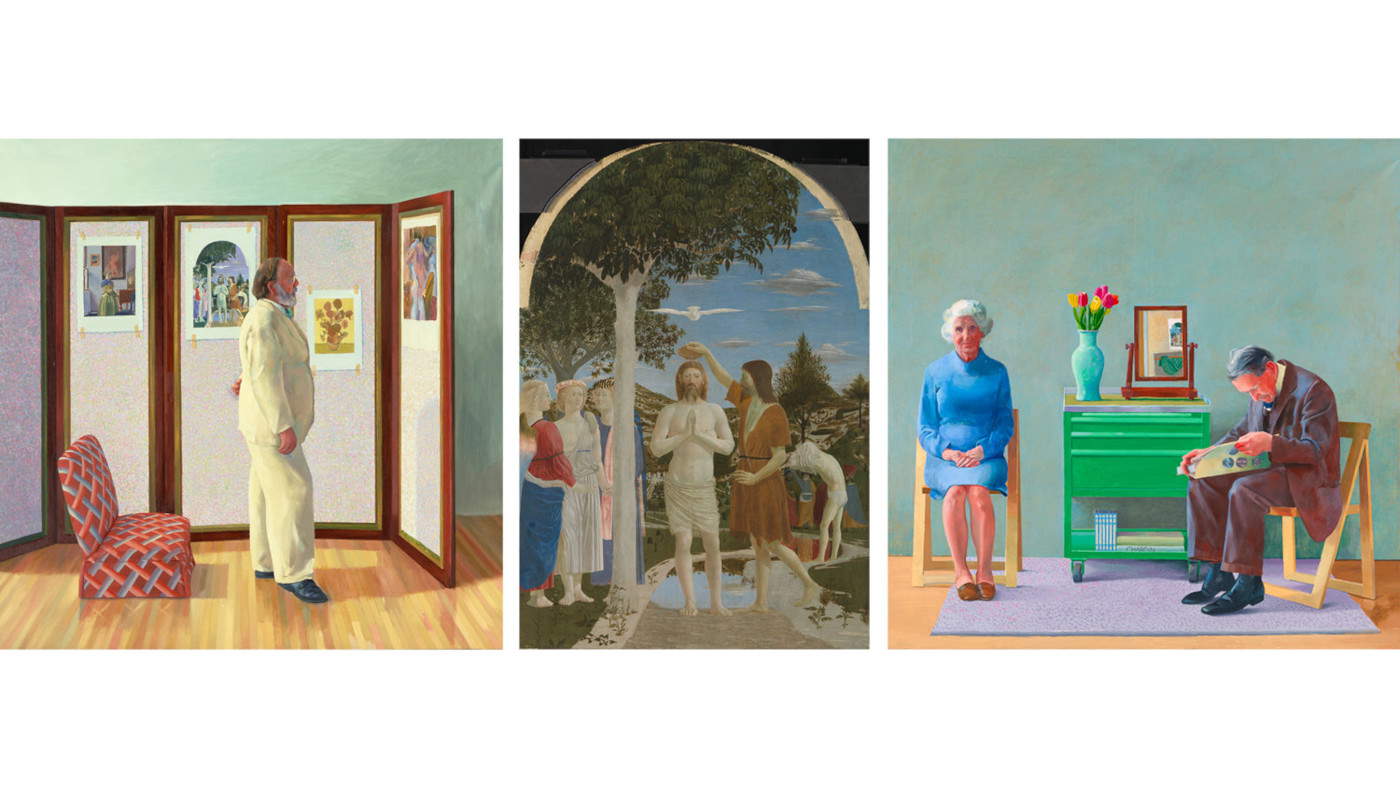Piero della Francesca's Baptism of Christ in two works by David Hockney. On view at the National Gallery
Two paintings by David Hockney (Bradford, 1937), considered one of the most influential British artists of the 20th century, feature within their composition reproductions of the Baptism of Christ by Piero della Francesca (Borgo Sansepolcro, 1412/1416 - 1492): these are Looking at Pictures on a Screen and My Parents, both executed in 1977. They are now on display until October 27, 2024 in Room 46 of the National Gallery in London.
The exhibition, titled Hockney and Piero: A Longer Look, explores the deep connection between David Hockney and the National Gallery, with a focus on his great interest in the museum’s collection and, in particular, in the work of the 15th-century Italian painter Piero della Francesca. Indeed, Hockney has admitted in the past that he wished he owned The Baptism of Christ so that he could observe it every day for an hour.
In Hockney’s painting My Parents (1977), created after two previous attempts to portray Kenneth and Laura Hockney, a reproduction of Piero’s The Baptism of Christ is reflected in a mirror placed on a carriage behind the portrayed subjects. In another 1977 painting, Looking at Images on a Screen, Belgian-born American friend and curator Henry Geldzahler is depicted gazing at a screen in Hockney’s studio, on which are attached four posters of some of his favorite National Gallery paintings, including The Baptism of Christ.
The exhibition then invites visitors to compare Piero della Francesca’s 15th-century work with Hockney’s two paintings, promoting"slow looking." According to Hockney, this way of slowly looking at works of art is key to helping people rediscover the beauty of the world around them.
In addition, this exhibition will be an opportunity to celebrate 200 years of collaboration between the National Gallery and contemporary artists, reaffirming the central role of the London museum in fostering an ongoing dialogue between artists, works and the public. This theme will be central to the National Gallery’s Bicentennial celebrations.
Accompanying the exhibition is an illustrated catalog that includes an in-depth interview with David Hockney. Other chapters explore the long relationship between artists and the National Gallery, showing how works such as The Baptism of Christ have continued to inspire generations of artists. The publication also reflects on the importance of the Gallery’s pioneering exhibitions, such as The Artist’s Eye series, in which Hockney participated in 1981 with Looking at Pictures on a Screen.
“I didn’t visit London until I was 18. The National Gallery was right there. They didn’t have exhibitions in those days. But I went there a lot as a student. I was always looking at Fra Angelico, Piero, Vermeer and Van Gogh. On those early visits I remember being struck by Piero’s ”Baptism of Christ,“ it was wonderful. I understand what reproductions do. They have enriched my life a lot and I know a lot by looking at them. On the other hand, when you see real paintings it’s a different experience,” Hockney said.
“As part of the bicentennial celebrations, this focus exhibition draws attention to the National Gallery’s powerful, if hidden, history as a catalyst for the nation’s creative life through its encouragement of contemporary artists to draw inspiration from its collection. David Hockney has been a lifelong devotee of the Gallery, as this ”conversation“ between two of his paintings and Piero’s The Baptism of Christ attests. We invite visitors to join this visual conversation, feast their eyes and remember the pleasures and benefits of careful observation,” said curator Susanna Avery-Quash.
Image: left: David Hockney, Looking at Images on a Screen, 1977. Private collection © David Hockney. Center: Piero della Francesca, The Baptism of Christ, probably circa 1437-45 © The National Gallery, London. Right: David Hockney, My Parents, 1977 Tate, purchased in 1981 © David Hockney. Photo: Tate, London
 |
| Piero della Francesca's Baptism of Christ in two works by David Hockney. On view at the National Gallery |
Warning: the translation into English of the original Italian article was created using automatic tools. We undertake to review all articles, but we do not guarantee the total absence of inaccuracies in the translation due to the program. You can find the original by clicking on the ITA button. If you find any mistake,please contact us.





























